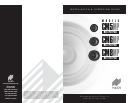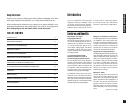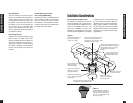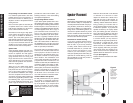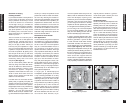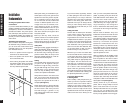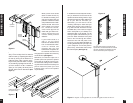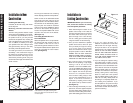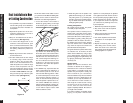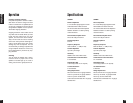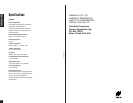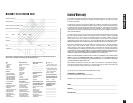
Installation in
Existing Construction
IMPORTANT: Before you cut into any
wall, review the sections on running
wire and speaker placement.
1. When determining the location of the
speaker cutout keep in mind that the
mounting dogs will extend 3/4" beyond
the cutout. make sure that you do not
place the edge of the cutout directly
next to a ceiling joist. Locate the joists
using a stud sensor or hand-knocking.
2. Once you have determined a possible
position for the cutout, drill a 1/8” pilot
hole just barely through the ceiling
(1/2” to 5/8” deep in most homes)
about an inch below the center of your
proposed speaker location. BE VERY
CAREFUL NOT TO DRILL THROUGH
EXISTING WIRES, PIPES, OR STRUC-
TURE. IF YOU FEEL ANY EXTRA RESIS-
TANCE AS YOU ARE DRILLING, STOP.
3. Cut a foot-long piece of coat hanger.
Bend the wire (creating a right angle)
leaving 4-1/8" at one end for the
CM5MP, 4-3/4" for the CM6MP and 5-
1/2" for the CM8MP (this allows for the
extra width of the mounting dogs). Poke
the “L-shaped” wire into the pilot hole
and turn it in a complete circle and
move it into the ceiling cavity to make
sure you have approximately 3-3/4" of
depth. If the wires movement is
obstructed by anything, fill the hole(s)
with spackle and try another location.
(See Figure 14)
4. If the coat hanger moves freely in a com-
plete circle, hold the supplied template
up to the ceiling surface. Outline the cir-
cular cutout on the ceiling surface with a
pencil. Drill starting point with a 1/4" bit.
5. If you are cutting drywall use a
sheetrock or keyhole saw. Cut the hole
with the saw at a 45° angle. That way,
the drywall section can be replaced
cleanly if there is an unseen obstruction
behind the wall. BE VERY CAREFUL
NOT TO SAW THROUGH EXISTING
WIRES, PIPES, OR STRUCTURE. IF
YOU FEEL EXTRA RESISTANCE AS
YOU ARE CUTTING, STOP.
6. If you are cutting into a plaster ceiling,
use masking tape to outline your pen-
ciled circle and use a razor to score the
plaster down to the lath beneath. Then
use a chisel to remove all of the plaster
within the taped outline. To actually cut
the lathe, two methods are used profes-
sionally; sawing with a metal cutting
blade on a sabre saw is the quickest
and the riskiest. Sawing a lathe with a
sabre saw can easily vibrate plaster off
the ceiling in a completely distant loca-
tion creating more patchwork. If you
have the patience, use a pair of tin snips
to slowly nip away at the lath instead.
There is little risk with this method, it is
just time consuming.
14
Installation in Existing Construction
Figure 14
Installation in New
Construction
Insulating the Wall Cavity
If feasible, fill the wall cavity with insula-
tion at this point.
Mounting The New Construction
Bracket
The hole saving bracket enables a faster
and cleaner final installation of the speak-
er. It forces the drywall installer to cut out
the speaker hole for you and provides
wire ties for the speaker wire, reducing the
risks of accidental loss or movement of the
wire. In addition, it enables you to align
your speakers with other ceiling fixtures
with great accuracy since you can really
see exactly where the speaker will be.
To install the bracket, first attach the
QuickSnap
™
new construction wings to
the bracket by snapping them into the
sides of the bracket. The wings can be
shortened by breaking them along the
scored lines if the length will interfere with
corner or eaves.
The wings and brackets have centering
lines to simplify placement of the speakers.
Screw one side of the assembled bracket
with wings to the joist using one of the
supplied screws. Level the bracket. Screw
the other side of the bracket/wing assem-
bly to the joist. Two screws on each side
make for a very secure installation. Secure
the wire to the bracket using bracket’s
wire tie. The drywall installers will cut the
drywall to the exact size of the bracket.
(See Figure 12)
Concealing Speaker Wire for a
Future Installation
Attach the speaker wire in a loop between
the ceiling joists and carefully mark the
exact location of the wire on a set of
plans. Ask the general contractor to inform
the drywall installers that the speaker wire
loops are concealed for future installa-
tions. (See Figure13)
13
Installation in New Construction
Figure 12 Figure 13
The optional hole saving brackets are installed
and the speaker wire is attached to the bracket.
The speaker wire is looped and hung on two
nails attached to the joists securing it for
future use. Make sure the location is noted
on house plans.



